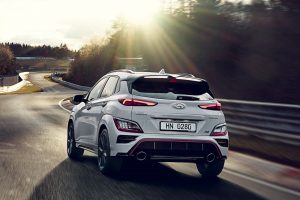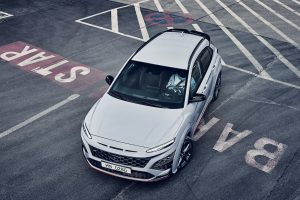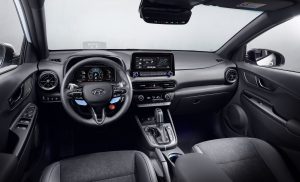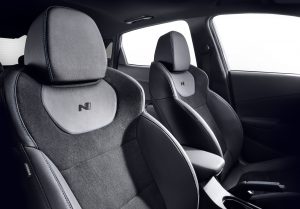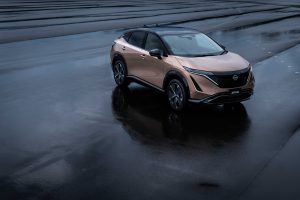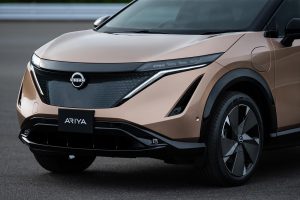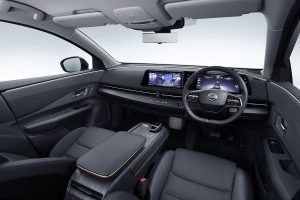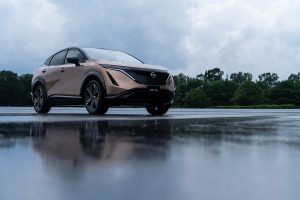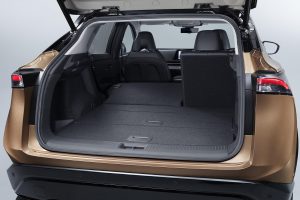Hyundai’s N family is about to grow again with the addition of the South Korean carmaker’s first high-performance SUV, the Kona N.
Until now, Hyundai has focused on more sporty models, like the Elantra and Veloster, to get the full-on N treatment. The Kona N not only becomes the brand’s first true performance utility vehicle but also hints at an even broader expansion of the brand that will see Hyundai introduce an electric N model in the not too distant future, officials suggested during a Monday evening media event.
The Hyundai Kona N is “a fun machine that looks like an SUV,” said global R&D chief Albert Biermann, “but it’s actually a hot hatch inside.”
Not your average Kona
While the N model maintains the basic shape of the current Hyundai Kona SUV, it has gone through extensive modifications, Biermann and other officials noted. That starts with the basic body and platform that have been stiffened to give the vehicle “racetrack capability(ies)” while retaining its basic day-to-day functionality.
In something of a surprise, Hyundai’s N team chose to stick with the base front-wheel-drive version of the Kona, rather than the all-wheel-drive model, something that helps keep it “affordable,” said Thomas Schemera, executive vice president of customer experience for Hyundai.
To give it a solid grip and track-ready handling, the Kona N gets the N Corner Carving Differential, an electronic limited slip differential. A power-sensing axle also helps direct torque where it’s most needed.
Even the base version also features Launch Control, a variable exhaust system and what Hyundai calls its “N Grin Control System” which “offers customers a high level of customization, with five distinct drive modes: Eco, Normal, Sport, N and Custom.
These drive modes change the character of the all-new Kona N by adjusting the operating parameters of the engine, Electronic Stability Control, exhaust sound, and steering to optimize them for a variety of driving conditions.”
Special features
Other features unique to the Kona include larger N-badged brakes, front and rear, modified to reduce fade even under aggressive track work, as well as lightweight, forged 19-inch alloy wheels.
Power comes from a turbocharged 2.0-liter inline-4 pumped up to 276 horsepower and 289 pound-feet of torque. That’s essentially the same as what motivates the Veloster N. The Kona’s N-Mode kicks in an extra 10 hp for up to 30 seconds — with a driver able to reactivate that boost every 40 seconds.
The engine is paired with an “enhanced” version of Hyundai’s 8-speed wet dual-clutch transmission.
The Kona N can hit 60 mph in 5.5 seconds using Launch Control and boasts a top speed of 150 mph. But the goal of the development program was to enhance cornering capabilities as well, said N brand chief Till Wartenberg.
“Getting from A to B,’ he suggested, “should never be boring.”
The Hyundai Kona N also undergoes extensive design modifications. These include a wider track, big air scoops below the familiar Hyundai shark nose grille, larger exhaust pipes and a twin-level rear spoiler with a distinctive, triangular high-mounted stoplight.
The Kona N gets body-colored fenders, eschewing the cladding of the standard Kona. It is offered in a unique Sonic Blue paint which Simon Loasby, the head of the Hyundai Styling Group, described as “stealthy. We wanted to create a color that was underneath the radar.”
Cool cabin updates
Inside, the Kona N goes all black, with subtle blue accenting. It gets metal pedals and unique seats, steering wheel and shifter.
The instrument panel features twin 10-inch displays, as well as a head-up display. The gauge cluster’s layout and color scheme changes with each mode, in N Mode switching to a single ring that’s easy to use on track. Numerous additional features are available in N Mode, including a stop watch and a graphic G-meter display.
Hyundai will launch the Kona N as a 2022 model during the fourth quarter of this year. Pricing wasn’t revealed. The Veloster N starts at $32,250.
Expect to see more Hyundai N models in the coming years, officials confirmed Monday night. There is the possibility of adding the performance package to the automaker’s other SUVs, said Schemera, depending on “market demand,” but there have been “no decisions yet.”
What is definitely in the works is an all-electric Hyundai N — and possibly more than one model, Biermann, Wartenberg and Schemera all agreed. That not only reflects the Korean automaker’s push into battery technology but also the fact that electric vehicles can make tremendous power. As to what models and when, “Stay tuned,” said Schemera.
/**/


